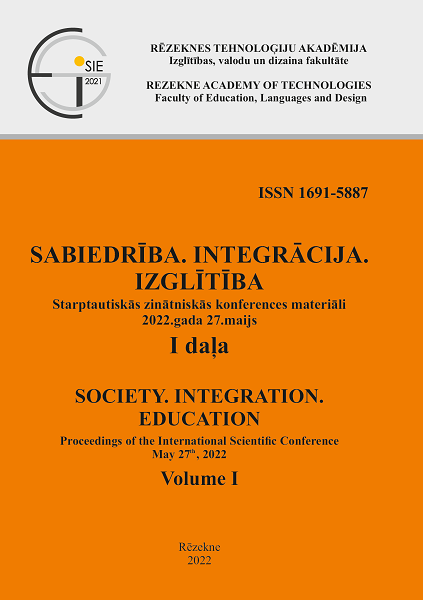VIRTUAL LEARNING OF ELECTRONICS
DOI:
https://doi.org/10.17770/sie2022vol1.6856Keywords:
remote work, simulation programs, virtual electronic systemsAbstract
The development of computer technology has enabled the emergence of new teaching opportunities in an artificial, virtual environment. It is then possible to work with electronic systems without the possibility of physical access to them and without measuring equipment. Such teaching and work with electronic systems was possible in a laboratory with computer stations with appropriate software. Only the development of network technology, and in particular the Internet, made it possible to fully virtual work at a distance. Until now, virtual learning has only been an alternative to teaching in a real hardware lab. It was also a supplement to the work that was carried out in the course of practical teaching with students. It was only the emergence of the Covid-19 epidemic that made this type of remote work learning a necessity, but also the only alternative in the event of school closings and quarantines. The necessity of distance learning inspired the use and development of many programs and information systems for this purpose. The paper presents selected programs that can be used and are used to learn electronics at a distance while working remotely. Each of these systems has its own advantages and disadvantages and can meet specific requirements.
References
Dobrowolski, A. (2014). Wirtualne przyrządy pomiarowe w laboratorium układów elektronicznych WAT (Virtual measuring instruments in the laboratory of electronic systems of WAT University). Zeszyty Naukowe Wydziału Elektrotechniki i Automatyki PG, Nr 37/2014, 373-380.
Jedrzejczyk, M. (2017). Analiza możliwości i zastosowania programów symulacyjnych wspomagających nauczanie elektrotechniki i elektroniki. (Analysis of the possibilities and application of simulation programs supporting teaching of electrical engineering and electronics). Wydzial Elektryczny, Politechnika Czestochowska
Kapica, J., & Scibisz, M. (2007). Zastosowanie programu MultiSIM do analizy pracy ukladów energoelektronicznych stosowanych w rolnictwie. (The use of the MultiSIM program to analyze the operation of power electronic systems used in agriculture). Inzynieria Rolnicza, 2(90)/2007, Katedra Podstaw Techniki, Akademia Rolnicza w Lublinie.
Nawrocki, W. (2002). Komputerowe systemy pomiarowe. (Computer measuring systems). Wydawnictwo WKŁ. Warszawa.
Noga, H., Olszewska, D., Ptak, P., Prauzner, T., & Migo, P. (2018). Badanie i symulacja oddziaływania zmiennego pola elektromagnetycznego na rozwój mikroorganizmów (Investigation and simulation of the influence of an alternating electromagnetic field on the development of microorganisms). Przegląd Elektrotechniczny, R 94, Nr 1/2018, 73-76.
Olszewska, D., Prauzner T., Krupa P., & Ptak P. (2018). Use of modern information technology in microbiological laboratory. Society. Integration. Education., Proceedings of the International Scientific Conference., Volume V, 380-389. Retrieved from http://journals.rta.lv/index.php/SIE/article/view/3281/3186
Prauzner, T. (2016). Interactive computer simulation as a response to contemporary problems of technical education. Society. Integration. Education., Proceedings of the International Scientific Conference, Volume II, 579-588. DOI: https://doi.org/10.17770/sie2016vol2.1415
Prauzner, T. (2017). The effectiveness of school education - featured implications considerations. Society. Integration. Education, Proceedings of the International Scientific Conference., Volume III, 558-564. DOI: https://doi.org/10.17770/sie2017vol3.2434
Ptak, P. (2018). Application of multisim and ltspice software packages to simulate the operation of electronic components as an alternative to measurements of real elements. Society, Integration, Education. Proceedings of the International Scientific Conference. Volume V, 409-419. Retrieved from
http://journals.rta.lv/index.php/SIE/article/view/3120/3189
Ptak, P. (2018). Application of the software package ltspice for designing and analysing the operation of electronic systems. Society, Integration, Education. Proceedings of the International Scientific Conference, Volume V, 402-408. Retrieved from http://journals.rta.lv/index.php/SIE/article/view/3118/3188
Ptak, P. & Prauzner, T. (2019). The use of modern information technology in teaching electronics. Society. Integration. Education., Proceedings of the International Scientific Conference, Volume V, 479-487. DOI: https://doi.org/10.17770/sie2019vol5.3937
Swisulski, D. (2004). Systemy pomiarowe (Measurement systems). Gdańsk: Wydawnictwo Politechniki Gdańskiej.
Szabatin, J. (2003). Podstawy teorii sygnałów (Basics of signal theory). Wydawnictwo WKŁ. Warszawa.
Trajdos, P. (2020). Analiza możliwości zastosowania programów symulacyjnych do modelowania układów pomiarowych wielkości elektrycznych i nieelektrycznych. Projekt układów pomiarowych przy zastosowaniu wybranych programów symulacyjnych. (Analysis of the possibility of using simulation programs for modeling measurement systems of electrical and non-electrical quantities. Design of measurement systems with the use of selected simulation programs.). Politechnika Częstochowska
Winiecki, W. (1997). Organizacja mikrokomputerowych systemów pomiarowych. Oficyna Wydawnicza Politechniki Warszawskiej. Warszawa.
Winiecki, W. (2001). Graficzne zintegrowane środowiska programowe (Graphical integrated software environments). Warszawa: Wydawnictwo Mikom.
Winiecki, W. (2003). Wirtualne przyrządy pomiarowe. O.W. Politechniki Warszawskiej, Warszawa.






